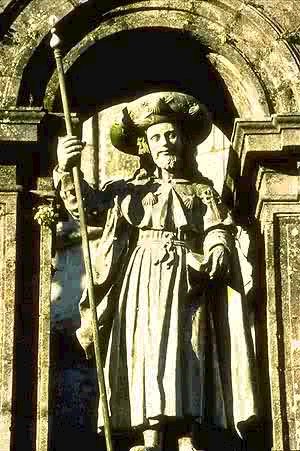

Christian legends tell that St. James the Elder, one of the twelve apostles of Christ, had traveled widely on the Iberian Peninsula, bringing Christianity to the Celtic peoples. Following his martyrdom in Jerusalem around 44 AD, his relics were supposedly taken back to Spain and enshrined. Due to Roman persecution however, the early Spanish Christians were forced to abandon the shrine and, with the depopulation of the area following the fall of the Roman Empire, the location of the shrine was forgotten. In 813 or 838 AD, so the legend goes, a hermit led by a beckoning star and celestial music discovered the location of the buried relics. Historians however, doubt that St. James ever visited Spain and the idea that his relics were transported to Iberia is thought to be a fabrication of the Church. The 'discovery' of the relics provided a convenient rallying point for Christian Spain, then confined to a narrow strip at the north of the Iberian Peninsula, most of which was occupied by the Moors. In addition to the story of the relics discovery there were also reports of Santiago Matomoro, or St. James the Moorslayer, appearing on a white horse in 844 AD to lead Christians into battle against the Moors. These two legends are interpreted by scholars of the Age of Medieval Pilgrimage as attempts by ecclesiastical authorities to gather popular support for the overthrow of the Arabs. Furthermore, it is known that officials of the Cathedral of Santiago actually hired storytellers to travel about the European countryside spreading 'news' of the miracles of St. James and his relics. While this deceit and corruption of the Church may shock some readers, it is a well-authenticated historical fact that many of the founding legends of medieval pilgrimage shrines were nothing more than tall tales. Such stories were conjured up by enterprising church administrators who recognized that the number of pilgrims visiting and donating money to a shrine was proportional to the miraculous nature of the founding legend and the degree to which that legend was promoted. Over the tomb where St. James' relics were 'found', the first church was constructed in 829 AD and within 100 years Santiago de Compostela was attracting pilgrims from throughout Europe. By the twelfth century it had become the center of the greatest pilgrimage in medieval Europe. While Jerusalem and Rome were considered the two most important pilgrimage destinations for Christians, because Santiago de Compostela was closer and much safer to visit, it received far more visitors. Four major land routes to Santiago developed over the centuries. Originating in northern France and meandering south through other pilgrimage sites, the routes joined, crossed the Pyrenees Mountains, and then headed to northwestern Spain. The Benedictines built monasteries and hostels to host the pilgrims journeying the routes to Santiago, creating what is perhaps the first major European tourist industry. The emotional appeal and morale boost provided by the cult of the saint swept through Europe as pilgrims journeyed to the 'Field of the Star' for centuries. While most came as true believers, a large number came as a stipulation to inheritance, as an alternative to prison, or simply in hopes of doing a brisk trade with the great numbers of visitors. The photograph shows a stone sculpture of St. James in the garb of a wandering pilgrim. The seashells fastened on his cloak were the badges of the medieval age, signifying a pilgrim's visit to the shrine of Santiago. The old city of Santiago de Compostela and its grand cathedral are among the most beautiful medieval artifacts in all of Europe. Besides the visual beauty of the place, the atmosphere is charged with devotion and holiness. The institution of the Church may have resorted to some unscrupulous tactics in advertising the site yet the many millions of pilgrims who visited the shrine came with love and sincerity in their hearts. The presence of that love is still strongly felt at Santiago de Compostela. |